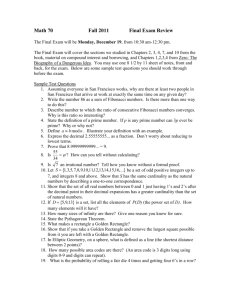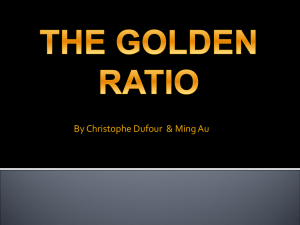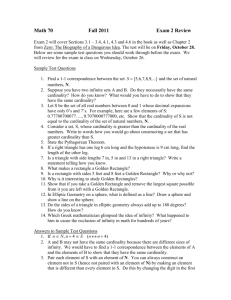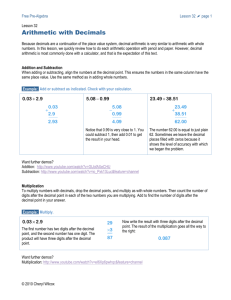2014Wisk_gr11_KW1_Projek
advertisement
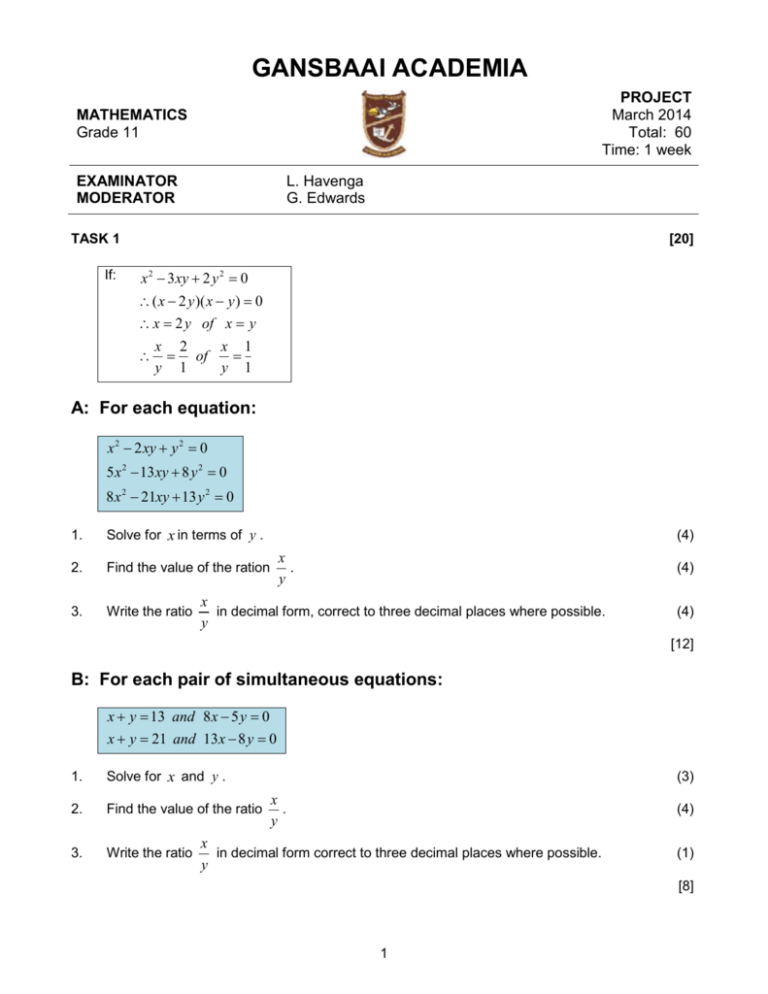
GANSBAAI ACADEMIA PROJECT March 2014 Total: 60 Time: 1 week MATHEMATICS Grade 11 EXAMINATOR MODERATOR L. Havenga G. Edwards TASK 1 If: [20] x 2 3 xy 2 y 2 0 ( x 2 y )( x y ) 0 x 2 y of x y x 2 x 1 of y 1 y 1 A: For each equation: x 2 2 xy y 2 0 5 x 2 13 xy 8 y 2 0 8 x 2 21xy 13 y 2 0 1. Solve for x in terms of y . 2. Find the value of the ration 3. Write the ratio (4) x . y (4) x in decimal form, correct to three decimal places where possible. y (4) [12] B: For each pair of simultaneous equations: x y 13 and 8 x 5 y 0 x y 21 and 13x 8 y 0 1. Solve for x and y . 2. Find the value of the ratio 3. Write the ratio (3) x . y (4) x in decimal form correct to three decimal places where possible. y (1) [8] 1 TASK 2 [8] You may have noticed that the numbers 1, 2, 5, 8 and 13 have appeared as solutions in Task 1. These numbers form a sequence called the Fibonacci sequence. In the Fibonacci sequence each number after the second term is the sum of the two before it. The table shows the first eight terms of the sequence (T1=term 1) T1 1 T2 1 T3 2 T4 3 T5 5 1. Write down the next three terms of the sequence. 2. Find a new sequence by finding the ratio. T6 8 T7 13 T8 21 (3) T2 T3 T4 T5 T ; ; ; up to 11 . T1 T2 T3 T4 T10 (2) 3. Find the ratios in Question 2 correct to three decimal places. (2) 4. Describe what you notice? (1) [8] TASK 3 [8] We can generate a sequence of numbers by continued square roots: T1 x ; T2 1 x ; T3 1 1 x ; T4 1 1 1 x ; T5 1 1 1 1 x 1. Use a calculator (or Excel) to find the first ten terms of this sequence for x 1 . Give your answers correct to four decimal places. Calculator tip: For T1 press 1 ; For T2 Press 1 Ans ; For T3 press 1 Ans and so on, for each successive term. 2. 3. Write down each term’s value in a table. (2) Find the first 11 terms of the same sequence for x 2 and x 3 . Record these values in the same table. (4) Describe what you notice about the values of the terms. (2) [8] 2 TASK 4 [8] We can generate a sequence of numbers by continued fractions: 1 1 1 1 1 T1 1 ; T2 1 ; T3 1 ; T4 1 ; T5 1 1 1 1 1 x 1 1 1 1 1 1 1 x 1 1 1 1 1 x 1 1 1 x 1 x 1. Use a calculator (or Excel) to find the first ten terms of this sequence for x 1 . Give your answers correct to four decimal places. Calculator tip: 1 1 For T1 press 1 ; For T2 press 1 1 1 ; For T3 press 1 and so on, for Ans Ans each successive term. 2. 3. Write down each term’s value in a table (2) Find the first ten terms of the same sequence for x 2 and x 3 . Record these values in the same table. (4) Describe what you notice about the values of the terms. (2) [8] TASK 5 [8] We have seen the number 1,618 (1,61803398 to be more accurate), in three different situations the ratio of the terms of the Fibonacci sequence continued square roots continued fractions. This number is called ‘phi’ or . It is an important number and is also called the Golden ratio. has many special properties. Let =1,61803398 1 1. Write down the value of 1 2. What do you notice? 3. Use the fact that 1 4. What kind of number is 1 5 ? 2 (1) 5. Determine that value of 1 5 correct to nine decimal places. 2 (1) . (1) (2) 1 to solve for and show that 1 5 . 2 (3) [8] 3 TASK 6 [8] The Golden rectangle is a rectangle in which the ratio of the sides is of approximately 1,618. 1 Throughout the ages this ratio has been recognised as aesthetically pleasing. Many buildings and works of art have the Golden rectangle in them. Two examples are the Parthenon in Greece and the United Nations building in New York, where the ratio of the width of the buildings compared with the height of every ten floors is the Golden ratio. Rectangle 1 has sides x and y with the ratio of length to breadth of x : y . y Rectangle 1 x y Rectangle 2 Rectangle 2 is formed by creating a swuare of lenght y on the one side of Rectangle 1. The remaining Rectangle 2 has sides of length x y and y with the ratio of length to breadth of y : x y . If the two rectangles have the same ratio of length to breadth, then they are Golden rectangles. In other words: x y . y x y 1. Show that the equation is the same as x 2 xy y 2 0 . 2. If y 1 , solve for x in the equation. Leave your answer in surd form. (2) (Why can we discard one of the values of x ?) (3) 3. What do you notice about this number? (1) 4. Use the equation x 2 xy y 2 0 to show that x , the Golden ratio. y (2) [8] TOTAL: 60 4


